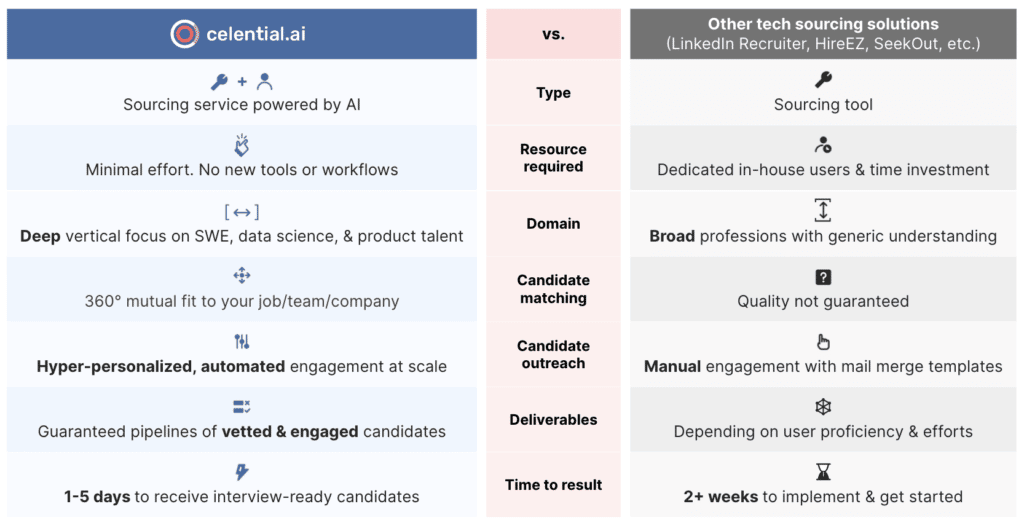In an increasingly crowded recruiting technology marketplace where there are more solutions than problems to solve, which sourcing tools for technical recruiters will really give you the best ROI for hiring tech talent?
Sometimes the answer isn’t the platform that can do a little bit of everything, but the company that can take over the entire job of sourcing for your recruiting team.
Let’s dive into what that means below and how Celential is automating the tech sourcing process, so recruiters have more time to close candidates.
What is Celential.ai?
Celential.ai offers a talent sourcing solution that helps our customers build a high-quality, diverse candidate pipeline in as little as three days.
Our vertical approach to recruiting AI has allowed us to graph 15M+ talent in software engineering, product, and data science across the U.S., Canada, Latin America and India, granting us substantial understanding and reach for tech talent that is typically inaccessible.
This talent graph identifies matches for our customers’ open roles faster and more accurately than any other sourcing solution on the market. Once we have identified quality candidates, our AI system crafts a personalized email and contacts those matches at scale.
We then send all the positive responses to our customers’ recruiting teams so they can do what they do best – focus on candidate experience and make hires.
Our technical recruiting domain expertise
If we were to summarize other sourcing tools in the market that use AI, we would say they go wide rather than deep.
The common horizontal approach to sourcing software engineers
LinkedIn’s automatic candidate matching for LinkedIn Recruiter treats all of its 500 to 700 million profiles as generic professionals. It and other outbound recruiting tools structure their candidate data for software engineers largely the same way they structure data for chefs or nurses.
In the end, you get similar insights for all three professions because you only know where they went to school, that they’ve been at their role for a certain number of years, and what keywords the candidate themselves has chosen to list on their profile.
The AI they use understands little in particular about what software engineers do, and not enough to understand if they’re good at it.
It gets even more complicated when you try to account for specialties.
Let’s say someone lists both Python and Machine Learning on their LinkedIn profile. For other solutions, these are likely two unrelated keywords. They don’t know how relevant someone’s skill in Python is to their work in Machine Learning.
You could say that kind of data is all very horizontal, even flat in some cases. The system then can’t rank signals as stronger or weaker to make meaningful inferences.

Celential’s vertical approach to sourcing software engineers
In contrast, our proprietary Talent Graph is vertically optimized for technical recruiting.
- It is a network of 15M+ passive tech talent that comes from our AI aggregating thousands of data sources, including community forums, academia, social networks, personal and company websites.
- It was built by experienced engineering leaders, so they understood the importance of distinguishing between the skills of software engineering, and connecting them based on popularity or their common relationship with one another.
- It combines rich data insights, to create more comprehensive profiles than what people just list on their social networks or resumes.
- We encoded technical recruiting domain knowledge into our AI algorithm, using a “white box approach,” and created an AI model that make meaningful conclusions from the Talent Graph rather than treat each data point as separate.
- Our AI finds and matches software engineers to companies, teams, and jobs like a human with domain expertise but at a scale never seen before.
Cutting Edge AI Candidate Matching
To see what we are talking about, here’s a comparison between a software engineer’s profile on LinkedIn and the one from our talent graph.

It’s often the case that people will only list “Software Engineer” as their job title on LinkedIn. Using the data insights we collect, our algorithm can reasonably determine whether someone is a frontend, backend, or full stack engineer, as well as their proficiency in relevant skills.
Taking it a step further, we can see the product domains they’ve worked in, their availability, and the likeliness they would respond to outreach. We can even tell right away their ethnicity for diversity search purposes.
Based on this information and how strong their professional experience is, we give a final grade on the profile that we use to accurately match to our customer’s job descriptions.
Need an engineer with Python experience?
Now, let’s see how deep our matching goes. If you are looking for a senior developer with 4 years of Python experience who would be willing to join your company, you might as well as be looking for a needle in a haystack.
Well, in this same profile above that we found through our Talent Graph, we’ve ranked this person as level five in Python.
Here are the steps to determining that ranking:
1. Public data sources
Level 5 is our highest ranking and that is because we found he has GitHub projects in Python; he’s published papers that involved working with Python; he’s answered questions on Stack Overflow regarding Python. He has demonstrated expertise with the language based on several independent, publicly available sources.
2. Inference from co-worker profiles
And our Virtual Recruiter doesn’t just look at those signals from sources with his name attached to them. It looks at what this person has done at past jobs.
For example, this person worked at PlanGrid. His profile doesn’t show anything specifically about working in Python professionally, but we can deduce that he worked in Python at PlanGrid.
How do we figure that out?
To begin with, we know that this person specializes in backend development based on the publicly available data about them.
From there, our Virtual Recruiter has compared this person’s profile with other developers who have worked contemporaneously in backend development at PlanGrid, and found that some of them mention working in Python during their time there.
That’s a signal that this person has worked with Python in particular professionally.
3. Inference from job requirements
Further, in scanning the job descriptions that PlanGrid has available in backend development, it finds that PlanGrid requires candidates who have experience in Python. That provides yet another signal to our system that this person has experience in Python.
Other platforms like LinkedIn just see that this person has Python on their profile. It’s possible that means this person is an accomplished Python engineer, but it could also mean that their computer science courses in college were taught in Python and they’ve never worked in it professionally.
That won’t be enough to go on for someone who is looking for a senior engineer who can deliver in Python from day one.

What if you need an engineer with AWS experience too?
It’s rare that a senior role will only require someone who is strong with Python. Let’s say your job description also requires 2 years working in AWS infrastructure.
This might be rather difficult since the example profile doesn’t mention AWS anywhere.
However, the Virtual Recruiter will consider the other engineers this person has worked with, and the technical stacks of the other companies where they’ve worked.
From that, it infers that this engineer actually has significant exposure to AWS. Further, it knows that PlanGrid uses AWS for their cloud infrastructure, so this person is likely doing the kind of work that would require working with AWS.
How about someone who can work in Machine Learning?
To move even further down the verticality of our system, maybe you are looking for an engineer that can apply these skills to machine learning applications. Our talent graph has a broader knowledge base about Python to draw on as well.
For example, Python isn’t only used for backend development. It’s also used for data analysis, data processing, data infrastructure, and machine learning. There are related skills to Python for these specializations like PyTorch, Pandas, or Airflow.
Other platforms can’t tell that these skills are related to each other. They’ll treat Python and PyTorch as being as similar or as different as Microsoft Office and Financial Advising, because at the end of the day they’re just keywords to them.
We can generate additional insights because our talent graph knows, for example, that if someone has Python and PyTorch then they’re more likely to be working in machine learning.
All these insights hone the profile even more for better matching. If someone is using Python for machine learning, it’s less likely they’re using it to configure a web API.
So while someone might have, say, Python, Flask, and PyTorch listed on their profile, if our system sees that they have a more robust set of machine learning skills than back-end web development skills, it’ll prioritize them for machine learning roles.
Unparalleled Candidate Outreach
Our product isn’t limited to identifying matches between a role and a candidate.
Often, customers who have been working with us notice that candidates react more enthusiastically to cold emails sent by our Virtual Recruiter than to those sent by their human recruiters.
We’ve been asked to consult with internal teams on how to replicate our personalized emails. But so much of what makes our candidate outreach work isn’t teachable.
Why?
Because a human recruiter working with a tool like LinkedIn Recruiter just doesn’t have access to the deep insights into software engineers’ backgrounds that we do.

Hyper-personalization at scale
Our AI-generated emails are personalized for each match by drawing on our extensive candidate knowledge and make the case for why a given role would be a fit for them.
Someone could conceivably try to copy those insights by putting hours of research into each candidate to determine what will get their attention — but that can’t be replicated at scale.
After all, quality software engineers are in such high demand that no matter how good your outreach is, many won’t reply to cold emails simply because they’ve been made extremely comfortable where they already are.
However, we’ve found that so many of those exceptional-but-content engineers aren’t truly closed off to new opportunities. They’re just tired of reading emails that are clearly a stab in the dark, a soup of keywords that aren’t at all relevant for them.
Our personalized outreach can generate as much as a 30% reply rate for the developers we target. There’s no other sourcing solution on the market that can boast those response rates for passive candidates.
We have the tools to tell them a compelling story about why they’d make sense for the role our system has matched them for, and we can do it in a miniscule amount of time compared to what it would take a human recruiter.
Wrapping Up
Need more reasons why Celential is the best choice for your technical sourcing function? Here is a quick breakdown of what separates us from other solutions.

With all of that deep knowledge and at-scale outreach, Celential can deliver warm candidates ready to interview for senior software development roles within three days. Book a demo today and see how Celential can supercharge your candidate sourcing.
Table of Contents
































